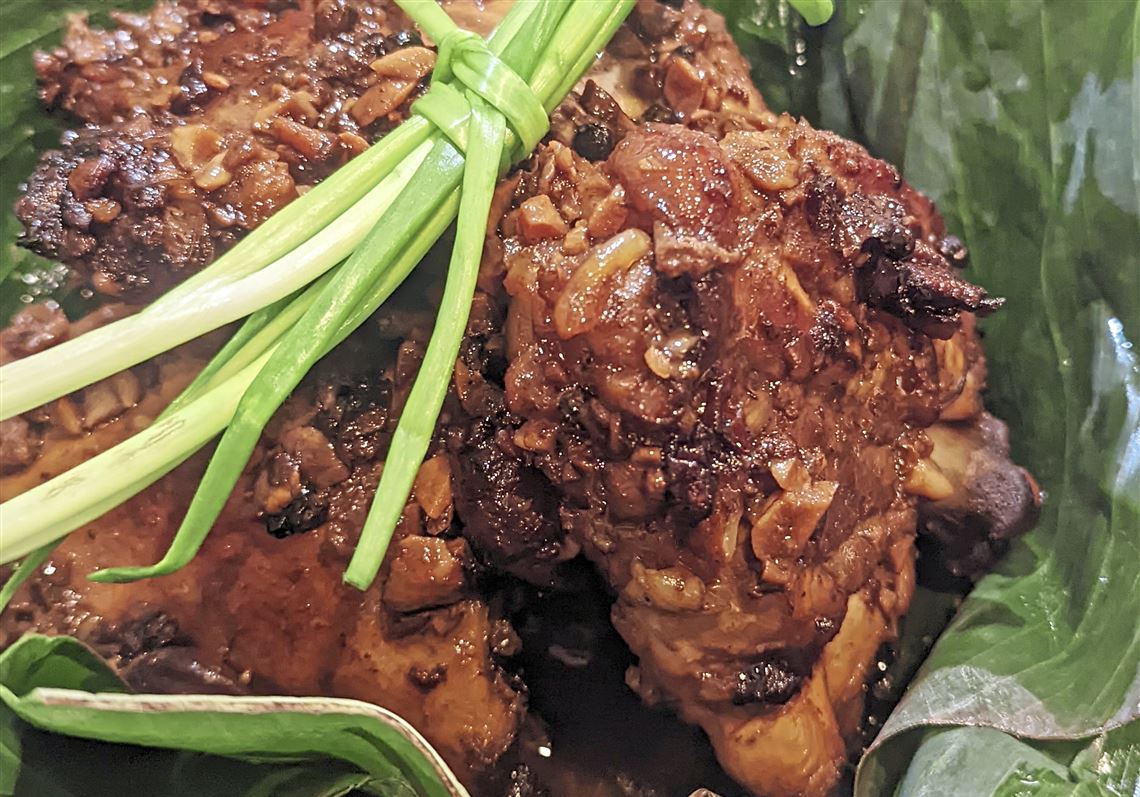For every culture, there’s that iconic dish that is its claim to fame. Koreans have kimchi, Italians have ragu alla Bolognese, French have pot-au-feu. For Filipinos the dish that has transcended is adobo.
If you haven’t had Filipino adobo, it isn’t the same dish that you get at a Mexican or Spanish restaurant laden with smokey peppers. Filipino adobo is usually pork shoulder or bone-in chicken braised in vinegar, garlic, peppercorns, and seasoned with salt. That’s it! However, one can imagine that through time and the varying cultures through the 7,100 islands that make up the Philippines, this original recipe has transformed a few times over.
I would argue that “adobo” is not the original name for the dish. The dish was first recorded in 1613 by the Franciscan Pedro de San Buenaventura as “adobo de los naturales,” meaning “adobo of the natives.” While its indigenous name was never recorded, we can at least thank San Buenaventura for specifying it as “native” because truthfully, this is probably the oldest recipe in the Filipino lexicon.
Adobo comes from the Spanish word adobar, which means to marinate. To marinate or not is really dependent on who the cook. So, it led me down another rabbit hole, where I learned that its name may have derived from the French word daube, which is a stew cooked with wine. Usually cooked with humble cuts of meat, the wine in daube was used as a natural preservative, much like vinegar is used in adobo. Did we just open up Pandora’s box?
Amid my efforts to learn more about Filipino culture in order to provide some intelligent insight for my half-Filipino daughter, I have not only opened the conversation about adobo but have learned of other adobo styles that I can envision certain family members giving a side eye to.
I started a group chat with friends and family members, which quickly went international. I even reached out to a Filipino historian from Manila, who added that “virtually any meat could be integrated in an adobo dish, adapting to what was abundant in the area.” A family friend who lives in Alberta touted buffalo, and an aunt in California talked non-stop about using squid. My uncle who’s turned health-conscious after a triple bypass loves using Japanese eggplant.
Then there was the debate about adding soy sauce — an ingredient introduced by China, the country that was the first ever to do trade with the Philippines. On the opposite side there was my godmother, my father’s sister, whose adobo represents the adobo of a Southern region, without the soy sauce, and actually no sauce other than the drippings and jus from the meat itself.
The degree of sauciness and what helps thicken the sauce — some use coconut milk — was also debatable. The conversation got thick, and that was when I got really hungry for adobo.
So, I drove to Niagara Falls to cook with my grandmother, Sarah San Juan, the owner of the famous Sarah’s, located just outside the University of the Philippines campus in Manila. As a snowbird, she spends the summer months in Canada and the balance of the year tending to her restaurant and store, where her chicken adobo has been famous since 1968.
Step by step she showed me, for the very first time, how to make her adobo while emphasizing how this dish put Sarah’s on the map.
“Wag kang ma takot sa tutong,” she said. Which is a headed warning not to freak out about the crispy bits at the bottom of the pan that will happen when adobo is cooked right; they’re the flavor to the dish. As I watched my grandmother taste, I asked her why adobo is such a popular dish, and her answer was congruent with everyone else’s: necessity.
Adobo doesn’t need to be refrigerated. The amount of vinegar in the dish is almost at the point of discomfort, but one has to trust the process. Filipinos have been doing this since man discovered fire. Adobo is at every Filipino party for that very reason. It has a humble appearance, with fifty shades of brown, and a curious aroma that will waft through any covered picnic area.
While the other ingredients may waver depending on how the wind blows in your part of the country, the constants are vinegar and garlic. My secret to a delicious adobo is using native coconut vinegar. It isn’t too sour and has a subtle sweetness, which really balances the dish.
My mother is from Manila and my father is from Bacolod, which is toward the South. So I am a purist loving my adobo with just a splash of soy sauce, which is down the middle between the adobos of both sides of my family. Personally, I like to marinate my chicken or pork an hour ahead of time in vinegar, garlic, a bay leaf, peppercorns and salt. I then braise my meat with that marinade, which is methodically Spanish in preparation, which reopens our initial conversation.
Call it adobo or not, this dish is a testament to what it means to be bold, as each ingredient holds its own. Its transformation from region to region in the Philippines, in North America, and quite possibly worldwide, exemplifies adaptability; some may argue this to be consequently Filipino. Nevertheless, adobo is a dish that naturally develops its flavor with time. And it's a one-pot sensation teaming with flavor. Most importantly, it’s a dish that welcomes you to make it your own, just as everyone else has.
Chicken Adobo
PG tested
6 pieces bone-in chicken thigh
1 cup Filipino sugar cane, or sugar cane vinegar such as Datu Puti (you also can use Coconut Secret coconut vinegar), divided
¼ cup soy sauce
3 tablespoons grapeseed oil or avocado oil
8-10 cloves of garlic
1 tablespoon whole black peppercorns
Salt to taste
3-4 bay leaves
¼ cup water
Steamed rice, for serving
In large bowl, combine ½ cup sugar or vinegar, bay leaves, peppercorn, salt, and ¼ cup soy sauce. Add chicken, stir to everything is well coated and marinate at least 30 minutes.
Heat oil in a Dutch oven or wok over medium-high. Make sure your pan has a lid.
Drain as much marinade off the chicken as possible, and reserve marinade. Using a paper towel, pat any excess marinade off the chicken.
Brown the chicken on all sides.
Add the marinade and all the chicken to braise. Add the remaining amount of sugar or vinegar. Cover your pan and allow it to braise for 15-20 minutes on medium-low heat.
Remove chicken from pan. Turn heat up to high.
Deglaze the pan with ¼ cup of water. Don’t be afraid of the renderings from the chicken, which stick to the pan. This will thicken your sauce and add more flavor. Scrape off as much of it as you can.
Serve chicken with the sauce and steamed rice and enjoy!
Serves 4.
— Kimberley Ashlee Haugh
Chef Kimberley Ashlee Haugh is the owner of Terrene in Station Square.
First Published: October 26, 2022, 10:00 a.m.
Updated: October 26, 2022, 10:07 a.m.


















